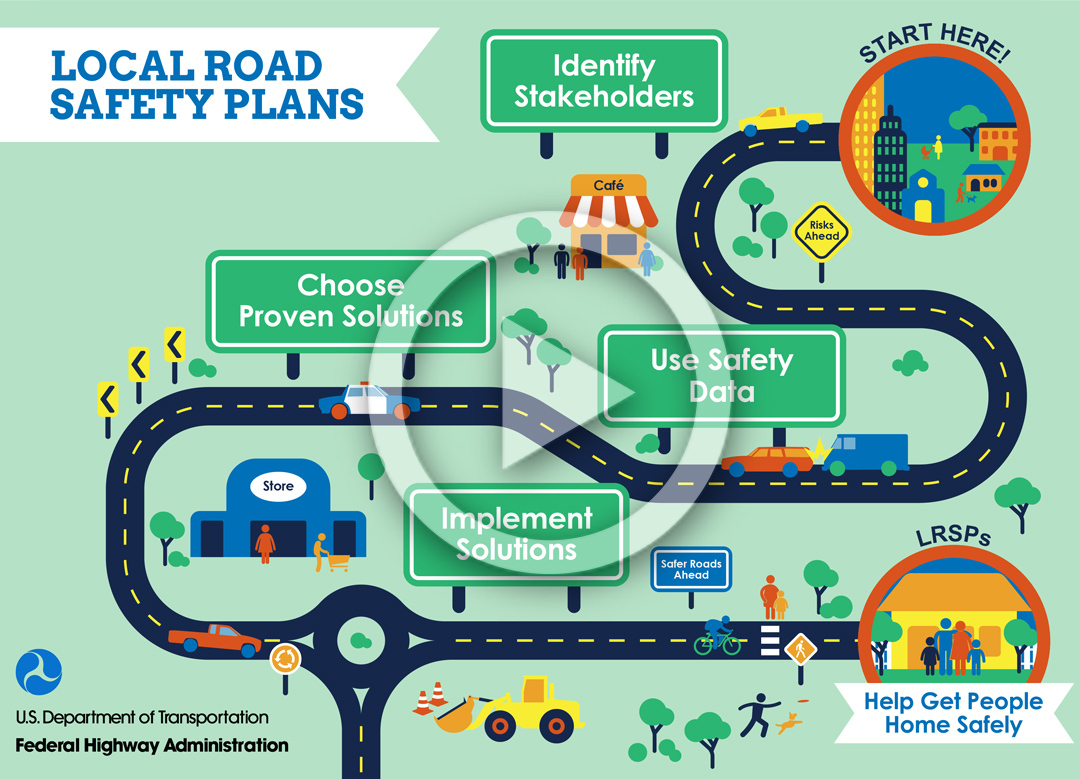Innovation of the Month:
Focus on Reducing Rural Roadway Departures
Last week, we discussed two of the four pillars of the focus on reducing rural roadway departures (FoRRRwD) initiative—recognizing that roadway departures happen on all public roads and using systemic safety analysis to identify those locations most at risk.
The next pillar involves taking those identified locations and developing strategies to address them in a safety action plan. These plans, whether simple or complex, are a powerful, data-driven way to prioritize safety activities and improvements and justify your investment decisions. A formal plan helps to communicate your priorities to other stakeholders including elected officials and the public, and may help secure any necessary funding. Last week we highlighted County Road Safety Plans in Minnesota, but any type of road agency can create Local Road Safety Plans (LRSPs).
The planning process has some key steps, obtaining stakeholder input, using crash and roadway data, and choosing proven solutions to implement. This process is scalable and can be modified for any level of available data and expertise. Data is critical to the plan, but lack of data shouldn’t prevent an agency from developing one. For instance, if traffic volumes aren’t available, agency staff can categorize the roads into low, medium and high volume. If roadway departures are occurring on curves for which geometric information is not available, a map can quickly help identify the sharpest curves or other areas that may require attention. Law enforcement, public health officials, and roadway maintenance staff are a great resource for this type of data.
 This infographic shows the overall steps to develop a Local Road Safety Plan. The graphic also links to an explanatory video.
In California, Caltrans piloted a project with five counties to develop LRSPs. When these pilot counties apply for Highway Safety Improvement Program (HSIP) funds, Caltrans can be confident these are data-driven safety projects. Caltrans is considering an approach which will require a local agency to have an LRSP or equivalent plan to qualify for HSIP funding.
Next week, we will look at some proven countermeasures for reducing roadway departures.
To learn more about developing a safety action plan to reduce severe roadway departure crashes in your jurisdiction, contact Cate Satterfield with the FHWA Office of Safety or Dick Albin with the FHWA Resource Center.
Bundling Helps Improve System Performance
Did you know project bundling has proved to be a valuable tool in all three major approaches to managing bridge condition and performance: preservation/preventive maintenance, rehabilitation, and replacement? It allows agencies to strategically focus resources and increase return on investment as they improve system-wide performance and safety.
The New York State Department of Transportation (NYSDOT) is combining the preservation needs of eight eastern counties into three project bundles, one each for preservation, painting and washing. NYSDOT also bundled 81 deck replacement projects into 9 bundles, improving the efficiency of program delivery. In total, NYSDOT replaced 116 bridge decks in two years using bundling.
Read FHWA’s Bridge Bundling Guidebook for case studies on these programs and others. For technical assistance, contact Romeo Garcia, FHWA Office of Infrastructure, or David Unkefer, FHWA Resource Center.
Delaware Develops Innovative Outreach Program for 2050 RTP
The Delaware Department of Transportation and the Wilmington Area Planning Council (WILMAPCO) developed a comprehensive public outreach strategy for its 2050 Regional Transportation Plan (RTP). WILMAPCO used traditional methods—engaging branding, popup events targeted in underserved areas, festivals, and municipal and civic meeting presentations—and virtual public involvement tools such as public outreach software, online surveys, and virtual public workshops to ensure opportunities for widest possible participation from the public. Social media promoted opportunities to engage with the RTP outreach program to nearly 40,000 people. Social media also allowed direct communication with the public, dissemination of project updates, and collection of public feedback and comment.
Through virtual public involvement, WILMAPCO engaged with nearly 1,900 individuals during the 2050 RTP campaign, more than double that of the 2040 campaign. Additionally, the 2050 RTP campaign generated over 600 public comments, up from only five during the 2040 effort.
A STIC Incentive Program Award supported WILMAPCO’s public outreach strategy.
To learn more about the WILMAPCO outreach effort, please contact Tigist Zgeye, executive director of WILMAPCO. If you’d like to learn more about virtual public involvement, please contact Scott Allen or Jody McCullough with the FHWA Office of Planning, Environment, and Realty.
|